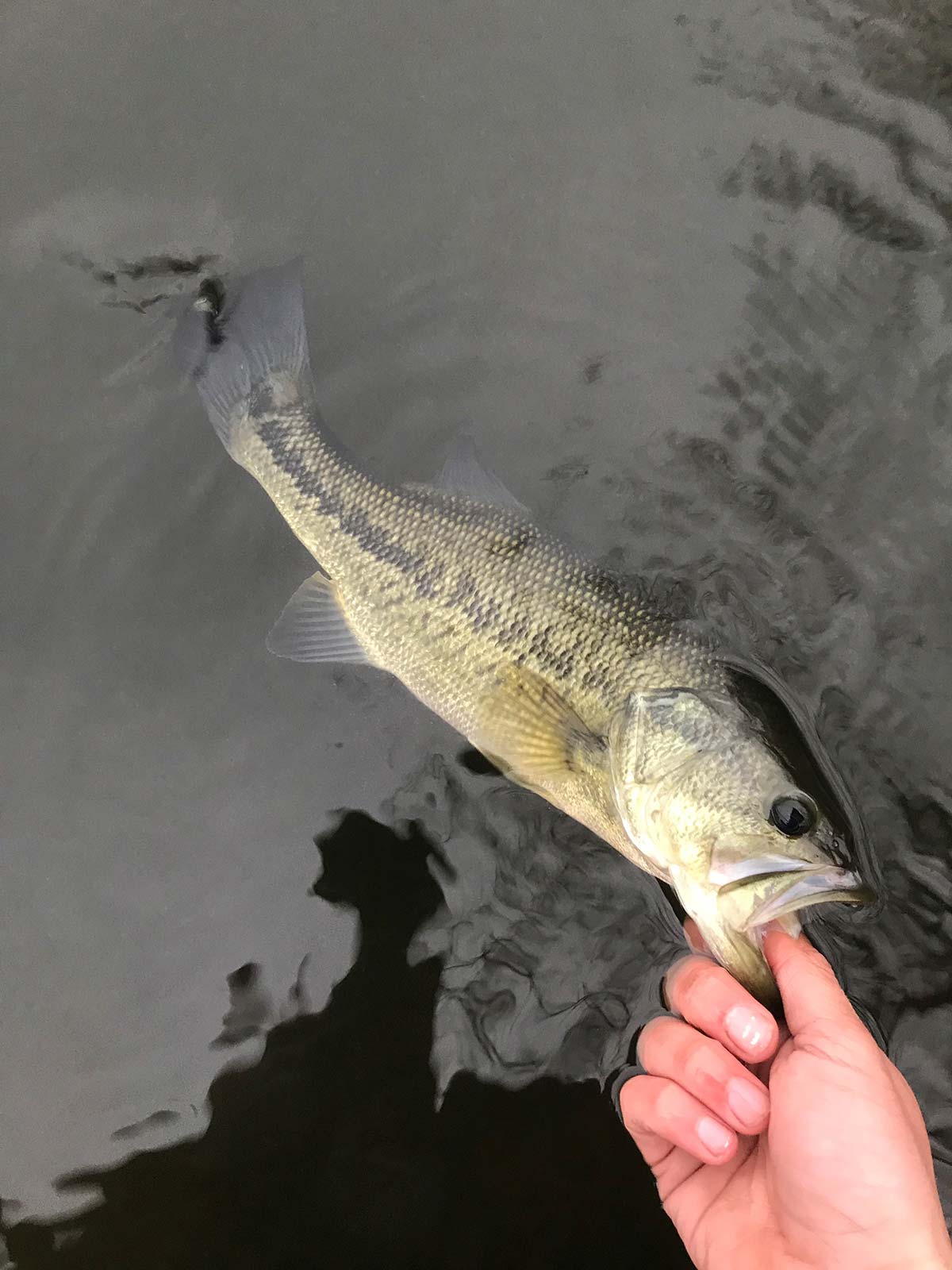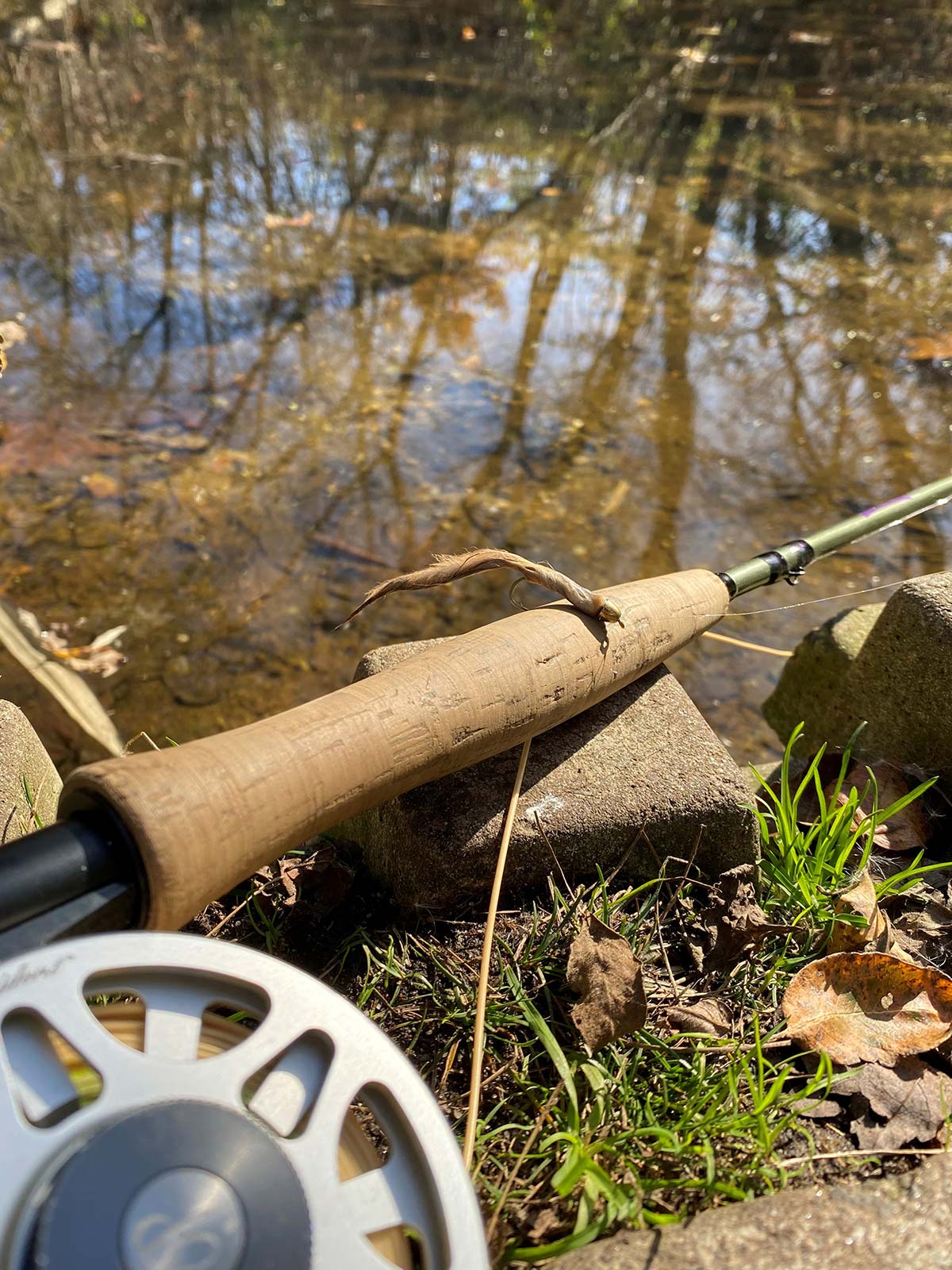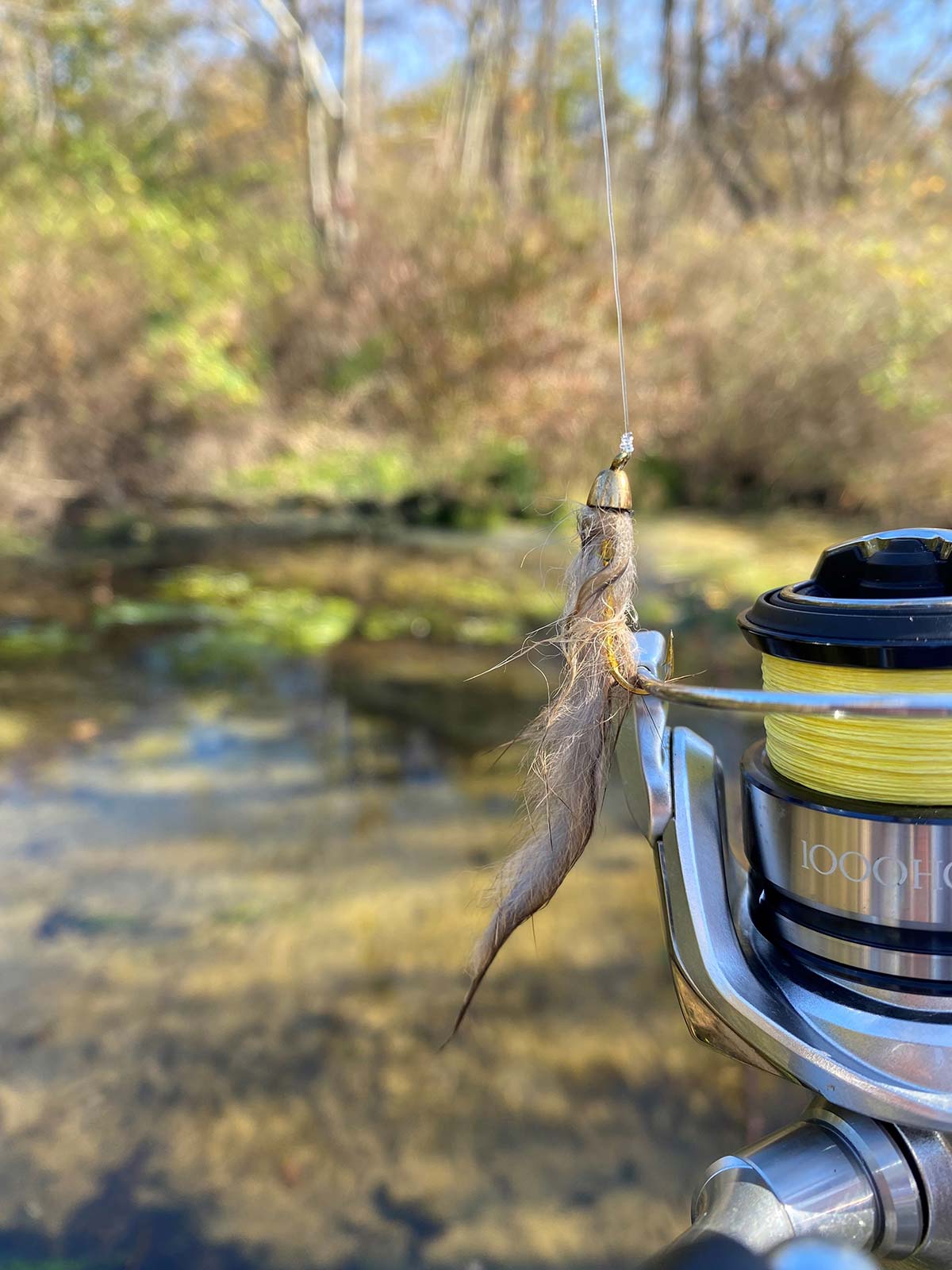
For spin and fly fishing, this fly will surly dupe sluggish winter bass.
There are very few instances in fishing when a fly is more productive than a lure. You may find this to be true during a mayfly hatch, or perhaps when very small bait is predominant. Fishing largemouth bass in shallow lakes and ponds in cold water, say right before the ice comes on, is another one of these few exceptions. And it won’t just be largemouths you’ll be catching under these conditions either. There’ll be plenty of crappie, bluegill, yellow and white perch, and pickerel in between the action with the targeted species to keep you pleasantly busy and very happy.
Simple Yet Effective
The effective fly is a simple one. It’s literally just a short piece of rabbit strip threaded on a hook with weight at the head. Although incredibly sparse, in addition to being so effective in this specific instance, the pattern just happens to be one of the deadliest streamer flies you could use for any freshwater gamefish on the continent!
The Rabbit Strip Jiggy is a creation of iconic fly tyer Bob Popovics. Although it can be tied in different lengths with different weights—for coldwater largemouths you want it short at 2-1/2 inches long—that’s a 2-1/2 inch long rabbit strip (Zonker Strip) which is attached to a #6 nymph hook, with a 3/16-ounce tungstun bead at the head of the fly. In tying, you start by threading the tungstun bead onto the hook and tie it in at the front, right behind the hook eye. The hook point is then pierced through the rabbit hide (on the hairless side), so that the hairs ride on the same side as the hook bend, barb, and point. All tying materials on one side of the hook shank, with none on the opposite side, like this, will force the fly to ride “hook point up”, no “jig hook” needed. You then tie the forward end of the straight rabbit strip in right behind the bead. That’s it! Again, rabbit strip on a hook with a tungstun bead head. Tungstun in a jiggy drops the fly faster, keeps it near the bottom better, and affords the fly (although not needed in this specific situation), more action than other weighted materials. It is a huge advantage in the jiggy. You can use any color rabbit strip but I like brown which is a natural pattern.

Fishing The Jiggy
So you want to fly fish with this, huh? All you need is a fly rod designated for a #4, 5, 6, or 7- weight line ( I use a 5 weight), a corresponding weight forward floating line, a fly reel which balances with this, a 9-foot leader, and a jiggy. I like a 2X tippet with this 2-1/2 inch fly which tests out to 8 pounds. You let the weight of the fly take it to the depths.
You don’t have to cast far. If you can’t cast past 30 feet, you’ll catch fish. I usually make casts from 30 to 70 feet. If you can’t fly cast well enough you can use the standard roll cast, which is simple to learn.
You want the jiggy on the bottom, where the fish will be, so you “count down” say to 20 or 30, perhaps more depending on the water depth. Immediately after the cast to allow the fly to get down to 6, 8, or maybe 10 feet. In many shallow bodies of water that’s enough to get down to the bottom. After the cast, point your rod out forward and down with that tip close to the water. The retrieve is easy and standard. By far the most productive technique is to make very long, steady, and smooth medium to slow one hand strips. I’ve tried so many different presentations under these specific conditions and this simple, basic one, which moves the fly straight and slow, has been the most productive by far. After a few strips pause and count down again to get your fly back to the productive zone. Then repeat stripping. You’ll identify the fish’s take by a light bump or “tick”, or more frequently by a tightening of the line or when you suddenly feel more resistance than usual on your retrieve. When you experience this, set the hook, which in this case can be just the vertical lifting of the rod, which is usually sufficient to get good hook penetration due to the small hook size. If the fish feels big, give it a couple more sharp jabs to insure a good “hook up”. This fishing is that basic, fundamental, and easy, as far as fly fishing is concerned, and is wildly effective.
Unmatched For Most
You will catch largemouths of all sizes, including perhaps the biggest in the lake. I’ve caught them up to 7 pounds in cold small water, and you’ll get panfish of all sizes as well. On many days you’ll be kept busy with lots of variety. Why, this past season I was surprised by a 9-pound pike, which had engulfed the small fly.
I’ve fished all kinds of standard “bass” lures in these conditions. Crankbaits, suspending stickbaits, spinnerbaits, rubber skirted jigs, various soft plastics, and have tried these so many times in this situation and nothing has been as consistently productive as the small Rabbit Strip Jiggy.

Spin It Too
You can use Rabbit Strip Jiggys on an ultra-light or light spinning rod if you want too. You may need to bump up in weight to, say, two medium size tungstun cones (threaded onto the hook to look like an egg) so that you can cast effectively. Use light leader, say 6,8 or 10-pound test, and super light braided line. After a pause to let the jiggy sink you just point the rod to the horizontal position with the tip near the water, then lift slowly and steadily to the vertical position to “retrieve”, reel back down and repeat, or just reel slowly and steadily. As with the fly rod, it’s a surprisingly easy technique to learn and master.
Materials For The Jiggy
| NOT JUST LARGIES |
| The Rabbit Strip Jiggy isn’t just a great fly for coldwater pond conditions, it’s actually (in 2-1/2 and 3-3/4 sizes—with varying weights at the head) one of the finest trout streamer flies (worldwide) I’ve ever seen, as well as a great steelhead fly, an incredible carp fly, and a fine smallmouth pattern. It’s deadly on pike and lake trout too, and you’ll have no problem catching stripers on it as well. Colors I like are white, fluorescent pink, olive, purple, and of course my favorite for cold water shallow lakes, brown. |
For your Rabbit Strip Jiggys buy the thin “Zonker Strips” in your favorite colors with some 3/16-ounce tungstun beads, along with some #6 nymph hooks (I like caddis pupae & shrimp down eye nymph). Purchasing medium size tungstun cones will allow you to tie jiggys to 3-1/2 to 4- inches long to try for other species besides coldwater pond fish, such as trout. By the way, I started tying that 2-1/2-inch fly using #10 and then #8 size hooks, but found that the bigger gap of the #6 allowed for much easier grabbing of the hook bend, leading to easier releasing of the fish with no handicap in hooking up whatsoever.
This is just such a fun, easy, and effective way for the fly fisherman to fish the many small lakes and ponds that dot every area of the entire Northeast, and really, most of the country, as the year gets late and the water cold. Under these conditions there may not even be a better way to fool ole’ big mouth bass.



